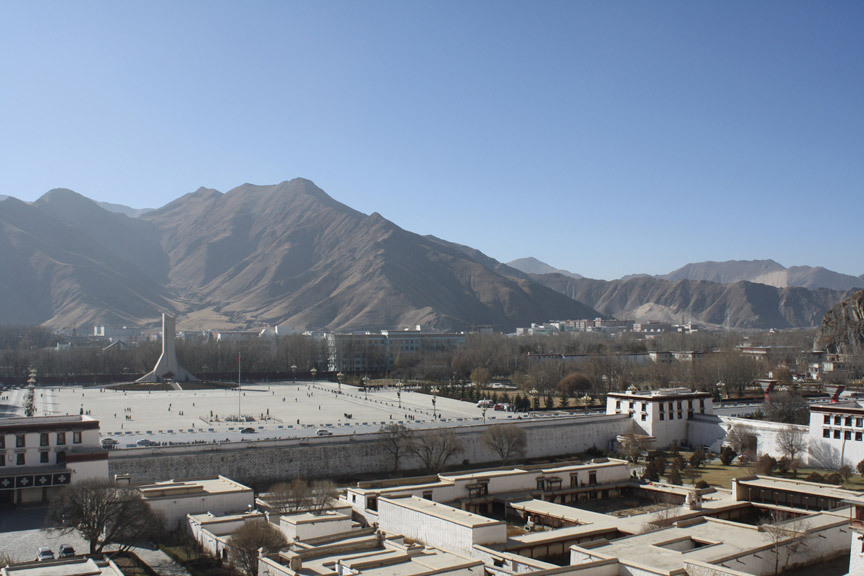In a river valley ringed by rocky mountains, Lhasa has abundant sunshine, even in December. Here, the view from the Potala Palace of the Chinese-built, spire-shaped monument commemorating the 50th anniversary of the “peaceful liberation of Tibet” by the People’s Liberation Army in 1950–51.
The exterior of Gendun Choepel Artists’ Guild, which relocated from a space near the Jokhang Temple to a new compound across the Kyi River in 2009. Twenty-six artists are now members of the Guild, which hosts primarily exhibitions of members’ works. Like many Tibetan buildings in the city, its cinderblock construction is complimented by traditionally ornate entrance.
An art professor at Tibet University, Benchung (b. 1971) stands next to one of his works in progress, I’m a Tibetan, So I’m Proud, showing himself in a meditation position wearing diapers. Working figuratively in a surreal but allegorical style, Benchung explains that the painting reflects the feeling of infantilization that he and many Tibetans felt as a result of the crackdown by Chinese authorities following the March 2008 riots in Lhasa.
The infantilization theme came up again in the work of Tsering Nyandak (b. 1974), who started his “Boy” series, showing a lone figure in a desiccated landscape, following an experience during the Tibetan riots. He says he was moved by seeing a young boy peacefully prostrating before a mother who was carrying her daughter, killed in the March 2008 violence. About the unfinished Girl with Balloon that Nyandak is standing next to (pictured), he comments that it is meant to express “not a celebration but a kind of melancholy, a breathing out.” He paints these imaginary landscapes, rather than working in new media or installation because he finds that “reality is too complicated.”
For much of the year, Tsewang Tashi (b. 1963) lives in Oslo, where he is completing a PhD thesis about 20th-century artists in Tibet. His light-filled Lhasa studio is located on the roof of his house and here is seen in front of several of his canvases. With his historical knowledge of Tibetan art and particularly the influence of Chinese and other foreigners who visited Lhasa in the 20th-century, Tashi is particularly interested in Lhasa’s transformation by outside forces. The large-scale green-hued portrait behind the artist, Beer Seller No.1 (2010), depicts a woman who works in one of Lhasa’s nightclubs as a promoter for a beer company.
One of Lhasa’s most commercially successful artists and a graduate of Beijing’s Central Academy of Fine Arts, Gade (b. 1971) is credited as being the first Tibetan artist to mix traditional motifs from thangka painting with imagery from American popular culture. Mickey Mouse, along with Batman, Spiderman and Ronald MacDonald remain regular characters in his work, as in new edition of cloisonné works showing the iconic figures posed like Tibetan deities. Here, Gade is showing off a new canvas featuring gold-painted silhouettes of figures recreating in an idyllic landscape.
Gade also revealed a new series made on black-painted paper, referring to the mystical nagtang tradition in thangka painting—which as an innovation of the 17th-century makes it a relatively recent development in Tibetan-Buddhist art. Over traditional thangka patterns, Gade cut out the forms of smaller figures and objects that he had fabricated from plastic stencils. In this work, the small icons (leaf, tree, trumpet, duck, machine gun, violin) form the larger shape of a reclining Buddha.
While the generation of Tibetan artists born in the 1960s and 1970s remains primarily involved in painting (though many have experimented with video or installation projects), younger artists are working with all varieties of media, particularly in sculpture and photography. On view at the Gendun Choepel Artists’ Guild in December was “Statements,” a show of artwork by Benchung’s students from Tibet University. This hilarious piece by Ninma comprised noisy toy helicopters with bronze prayer wheels on top that spun around when the little vehicles were switched on.
In the same student show at Gendun Choepel Artists’ Guild, Sherob Droje had visualized a first-person-shooter video game in the streets of Lhasa—a particularly edgy work given the palpable tension in Lhasa’s streets. While the two figures, prayer flags and writing are clearly Tibetan, the identity of the protagonist and target are unknown, though surely the “good guys” are Tibetan in this scenario.
Tenzin Dargya (also known as Tendar) primarily works as a traditional thangka painter of private commissions that are given as donations to monasteries. Here, one of these works is seen in the foreground, on traditional stretchers. But Tendar has also begun to make works of his own composition and motivation while still adhering to thangka styles, as in the unfinished, blue work on canvas, which showed something resembling a giant meteor containing a landscape of revered Tibetan-Buddhist sites.
Primarily a self-portraitist, Nortse (b. 1963) is a man of few words. His dark studio, located in his home, which he and his wife were in the process of leaving for a larger space in a new neighborhood, has a small private shrine, meat hanging from hooks as it dries and years worth of paintings in a back room. On a table, I noticed a volume of Joseph Beuys’ writings, translated into Chinese.
Canvases in progress, by Nortse. The artist often works by having images printed onto canvas and then painting over them. The painting on the left shows notes of Chinese renminbi protruding from a broken bronze Buddha. The middle work was made by covering up a self-portrait with a field of Tibetan prayers and postcards from a recent show. The canvas on the right, featuring Nortse’s signature motif of a bandaged head, recalls both a military formation and the artist’s own admitted struggle with alcohol.




